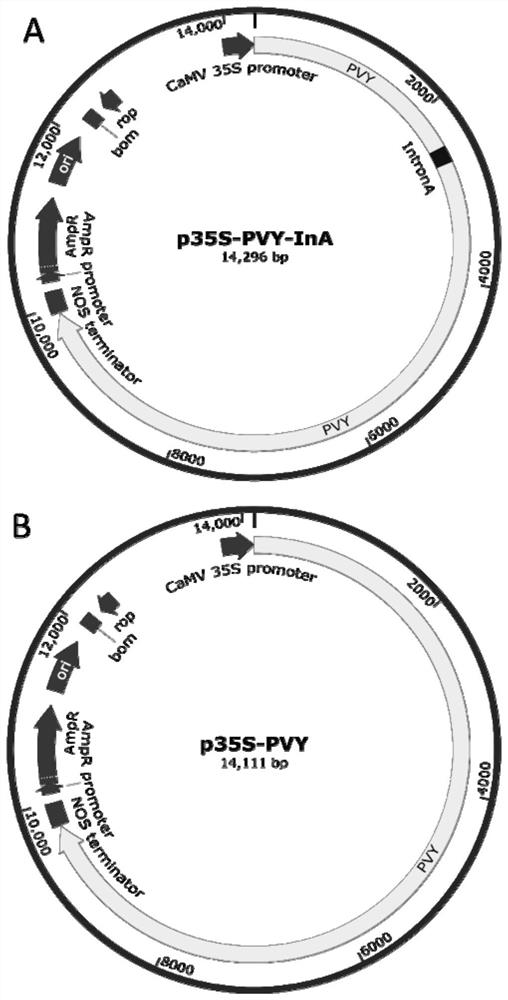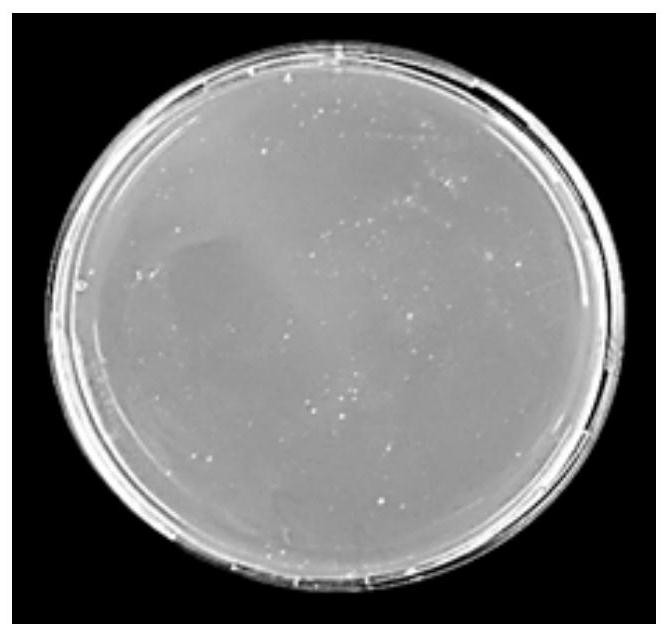Methods of Proliferating Functional Potato y Viruses in Prokaryotic Cells
A technology of prokaryotic cells and potatoes, applied in the biological field, can solve the problems of increasing the potential for virus sequence mutation, non-viral nucleotides, affecting virus infection, transcription, and the inability of viruses to successfully construct invasive clones, etc., to improve Intrinsic Toxicity, Effect of Yield Improvement
- Summary
- Abstract
- Description
- Claims
- Application Information
AI Technical Summary
Problems solved by technology
Method used
Image
Examples
Embodiment 1
[0062] Example 1 Construction Strategy
[0063] Reported PVY NTN-NW The strain isolate SYR-II-2-8 (GenBank accession number: AB461451) has a prokaryotic promoter-like element in the P3 gene ( figure 1 , bold and underlined), according to this result in PVY NTN-NW A prokaryotic promoter-like element was also localized in JL-W1 of the strain isolate ( figure 1 , bold underline mark), in the middle of the element ( figure 1 , the bold italic mark) was inserted into intron A (IntronA / ST-LS1 / S. tuberosum) of SEQ ID NO.2 to disrupt its structure, thereby blocking the expression of viral proteins in E. coli.
Embodiment 2
[0064] Example 2 Amplification and ligation of fragments of invasive clones
[0065] Using the JL-W1 isolate cDNA, potato DNA and plasmid containing cauliflower mosaic virus (CaMV) 35S promoter preserved in the laboratory as templates, the virus fragment, intron and vector fragment were amplified respectively. A 50 μL reaction system was used for PCR amplification: PrimeSTAR HS (Premix) 25 μL, template 1 μL, forward primer (10 μmol L-1) 1 μL, reverse primer (10 μmol L-1) 1 μL, and ultrapure water 22 μL. PCR conditions: denaturation at 98°C for 10s, annealing for 10s (annealing temperature is shown in Table 1), extension at 72°C for several minutes (the extension time is calculated as 1 kb / min), a total of 30 cycles. After the reaction, PCR products were detected by 1.5% agarose gel electrophoresis. After detection, the target band was cut out and purified using a gel recovery kit, and the purified product was stored at -20°C.
[0066] The primers used to construct and verify...
Embodiment 3
[0076] Example 3 Identification of recombinant plasmids
[0077] (1) Enzyme digestion identification: 5 μL of each extracted plasmid was taken, detected by 1% agarose gel electrophoresis, and the plasmids meeting the expected size were screened. Afterwards, the restriction endonucleases BamHI and PstI were selected, and the recombinant plasmids meeting the expected size were respectively subjected to single-enzyme digestion verification. After the reaction, 1% agarose gel electrophoresis was used to detect the result of restriction digestion.
[0078] Pick a single clone colony for plasmid extraction, and the extraction results are analyzed by agarose gel electrophoresis, such as Figure 4 As shown (M: DNA molecular standard; 1-12: plasmid Z1-12), the plasmids were all in line with the expected size.
[0079] The positive recombinant plasmids screened by BamHI and PstI were subjected to single-enzyme digestion verification using restriction endonucleases, and the verificatio...
PUM
 Login to View More
Login to View More Abstract
Description
Claims
Application Information
 Login to View More
Login to View More - R&D
- Intellectual Property
- Life Sciences
- Materials
- Tech Scout
- Unparalleled Data Quality
- Higher Quality Content
- 60% Fewer Hallucinations
Browse by: Latest US Patents, China's latest patents, Technical Efficacy Thesaurus, Application Domain, Technology Topic, Popular Technical Reports.
© 2025 PatSnap. All rights reserved.Legal|Privacy policy|Modern Slavery Act Transparency Statement|Sitemap|About US| Contact US: help@patsnap.com



